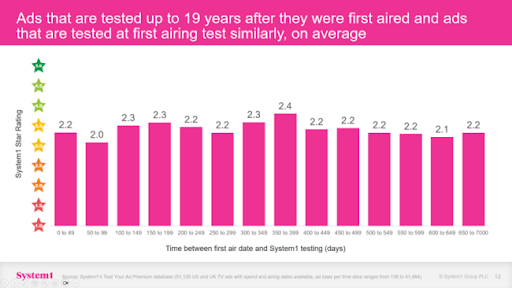Why wear-out matters
There is no evidence to suggest that ads become less effective as they age, but it may feel like they do, especially when as a brand or an agency professional you are watching the same piece of creative for the millionth time by mid-October.
In short: if it ain’t broke, don’t fix it.
The myth’s presence, however, doesn’t just threaten wasted effort but a lot of wasted money at Christmas and beyond: creative is too often taken off air and replaced before viewers (even potential customers) have become familiar with the message, restricting its full impact.
This suggests that more brands should consider sticking with a campaign idea to maximise its effectiveness and squeeze the most commercial benefit out of creative work, chiming with emerging evidence that advertising needs a sustained budgetary and creative commitment in order to be successful.
What’s going on
Data from System1, based on the research firm’s Test Your Ad platform, finds that not only recurring characters but even recurring ads retain their potential to be effective. The platform predicts long and short-term effectiveness based on consumers’ emotional responses.
System1 compared the Star Rating of ads by the time elapsed since their first airing. The analysis covered over 50,000 ads and went back up to 7,000 days, a 19-year period.
- Retention: “The evidence shows that effective ads and characters are effective every year, with 5-Star ads retaining their effectiveness when re-used,” explains Jon Evans, System1’s chief customer officer. “Christmas ads don’t usually wear out, and festive characters actually wear in.”
- Evidence of wear-in: System1’s top two festive ads this year – Aldi’s Kevin the Carrot redux in top position with the M&S Fairy just behind it – didn’t score 5-Stars on their first appearance. “But marketers invested in them and had a long-term plan, and now they’re getting our maximum score for long-term effectiveness,” adds Evans.

Source: System1
Top of the recurring elements league
- Aldi brought Kevin the Carrot back for the eighth time and again scored a 5.9-Star maximum. Every year for the past five years, Aldi ads featuring Kevin the Carrot have been 5-Star ads.
- M&S Food brought back their M&S Fairy for the third year running and achieved their first maximum, 5.9-Stars.
- The National Lottery last year scored 5.7-Stars and it stayed in the elite 5-Star bracket with 5.1-Stars this year.
- Cadbury Secret Santa campaign, which first appeared in 2022, scored 5.3-Stars this year after scoring 5.2-Stars last year.
- Coca-Cola: Holidays Are Coming’s rerun gets the maximum score of 5.9 stars.
Tailoring for attention
Figures from CreativeX suggest that advertisers are wasting a lot of media dollars by inadequately repurposing festive ads for TV on digital platforms. This is because they fail to design for the different kinds of attention that different media attract.
Worldwide, the tech company claims, as much as $600m of ads (based on an overall assessment of 3.9 million individual ads during Q4 ‘21-22) were not digitally suitable for the environment in which they appeared.
“Millions are invested in ads that do not include any branding in the first 3-5 seconds (the average view length of a digital video), are formatted incorrectly, or fail to include subtitles or supers in media environments where 90%+ of videos are watched without sound, all basic creative quality criteria that’s been shown to deliver better performance on digital,” a statement from the firm reads.
Key quote
“There’s little more frustrating than seeing brilliant, 5-Star ideas and characters with huge potential being scrapped just as they’re starting to work with the public. It’s a form of short-termism that doesn’t make creative or financial sense. Often the boldest decision a marketer can make is to stick with what’s working and reject novelty for its own sake”
Jon Evans, chief customer officer, System1.
Source: warc.com

